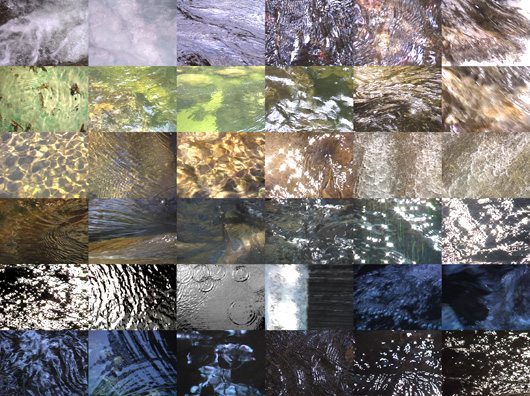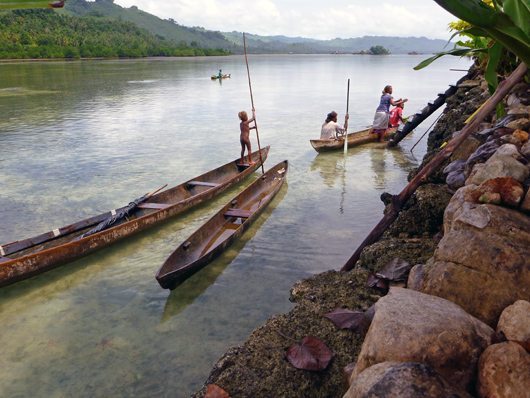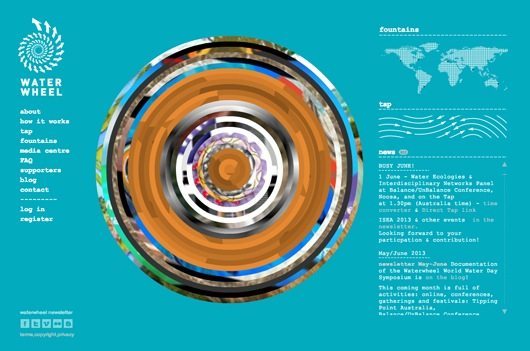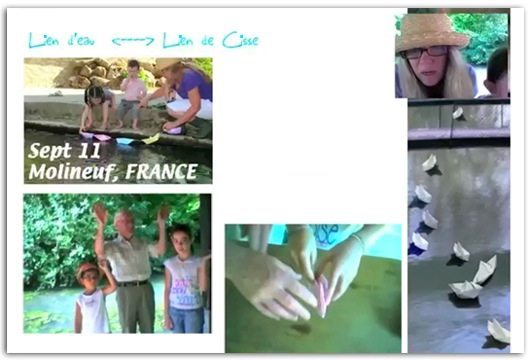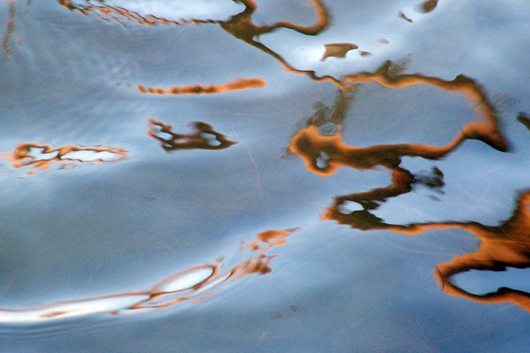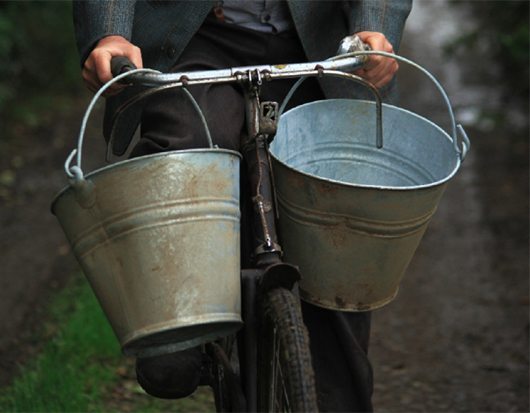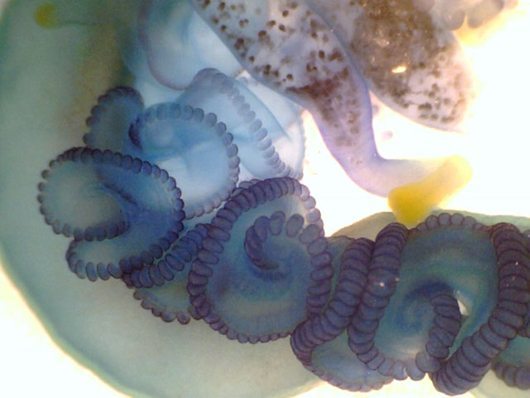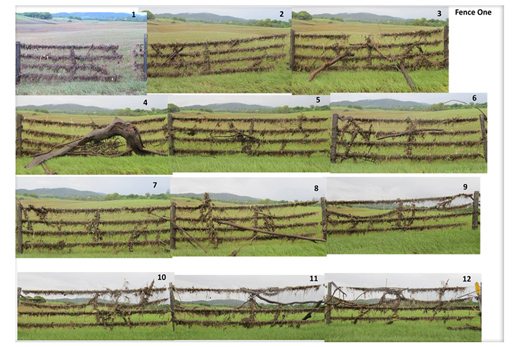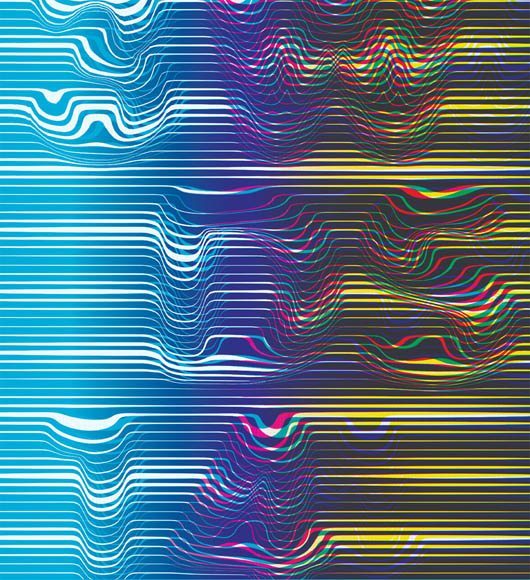Title: WOMEN ARTISTS CONNECTING & COLLABORATING ON WATERWHEEL
I. WATER: A LINK ACROSS CULTURES
AS AN INTRINSICALLY EXPERIMENTAL artist I am deeply committed to making & developing art that examines, reflects upon, and helps us survive today’s disjointed worlds. Artistically, I have been fascinated by water for many years, collecting video, stills and sound, interested by its contrasts and extremes – transparency, opacity, stillness, turbulence and violence; by its movements and patterns. Researching networked performance, looking at meshing form and content, I observed that water’s fluidity, stripes and rhythms make links between graphic, choreographic, musical and cinematic forms.
I come from a country in Europe where water is often considered a commodity and taken for granted, as it rains a lot. For three years in the early ’90s, I lived in a part of India where access to water regulated life. When I moved to Brisbane, Australia, I saw the city going through severe drought for several years and then big floods. These events made me more aware of water issues and the politics around water, and led me to conceive Waterwheel, an ongoing project open to all, for cross-disciplinary and cross-cultural dialogues and exchanges around the globe.
II. ART, A WAY TO TALK ABOUT & UNDERSTAND WATER
WATER IS PRESENT IN ALL CULTURES through stories, rituals, songs, etc. Artists (and others) are attracted by its beauty and metaphorical power. Who can resist watching and listening to the sea, a stream or a fountain? It speaks a common language that we all share. Artistic whimsy, intervention and poetic interpretation are ways artists engage the public in matters of importance, which include presenting alternative perspectives on the governance, protection, access and health of water in general, and particularly waterways.
III. CREATING WATERWHEEL
WHILE I WAS BECOMING INCREASINGLY aware of water issues, access and politics, I was also developing my interest in the growing genre of networked performance, or performance on the Internet that uses mass communication tools. When I received a Fellowship from the Australia Council for the Arts to pursue my research on the Internet, I decided to combine my two interests in one project: Waterwheel, an online place where people can meet to share, present and perform about water across disciplines, cultures and ages.
You are welcomed on the homepage by a wheel, which ripples and expands with people’s latest media contributions, represented by concentric rings.
These media are stored in the MEDIA CENTRE, a growing collection of shared water-related audio, images, video, text, spreadsheets & animations. People, whether or not they are registered, can consult the media centre by using the advanced search to explore artists’ works, projects or topics, out of personal interest or in order to curate exhibitions, festivals or conferences.
The FOUNTAINS represent past and future events, in ‘real physical’ spaces or on the Tap, on a global map/timeline.
IV. WHAT IS THE TAP?
THE TAP IS A WORLD-PREMIERE AND what makes Waterwheel so powerful. It is the result of many years of research and a team work1. It is a kind of Skype group video (for 6 webcams), meets YouTube (for all kind of media, not just video) plus a ‘whiteboard’ with real-time drawing and text chat. All webcams, drawings and media items can be re-positioned, re-sized, faded and overlaid. All changes are viewable instantaneously on a single webpage. Users can invite their own ‘crew’ to present publically or in private. Audiences can watch a live event with just one click.
V. SOME PROJECTS ON WATERWHEEL
WATERWHEEL AS AN ONLINE COLLABORATIVE platform allows anyone to share their perspective on water, make and develop independently their own projects, with collaborators of their choice, whenever they want.
From the independent projects that I have followed, I really loved and enjoyed Lien d’Eau3, one of the very first projects, initiated by the artist Aprille Glover.
Aprille worked with the entire community of a small village in France, getting children to draw their river and meet their elders who told them stories about it. They wrote these stories on the backs of their drawings. Together, they transformed them into paper boats and then launched these boats and filmed ‘live’ on the river on the Tap, Waterwheel’s videoconferencing/media mixing system.
I curated the WEAD exhibition Convergence/Divergence 4 last year, and proposed to coordinate a symposium 5 with some of the artists and scientists, giving more insight about their work to the audience, on site in the exhibition, and online. Leah Barclay was a special guest and talked about the international conference Balance/UnBalance she was co-chairing in Noosa biosphere, last June. This conference aims to give ‘a deeper awareness and creating lasting intellectual working partnerships in solving our global environmental crisis, using art as a catalyst, exploring intersections between NATURE, ART, SCIENCE, TECHNOLOGY and SOCIETY as we move into an era of both unprecedented ecological threats and transdisciplinary possibilities 6 ‘.
This was a great occasion to meet one of the WEAD members, Deanna Pindell who travelled to Australia to attend several conferences.
Water Ecologies & Interdisciplinary Networks 7 is a panel discussion I organised in the context of Balance/UnBalance Conference. I gathered five people who each initiated a network about water. They were from different parts of the world, different cultures and different disciplinary backgrounds (a scientist in hydrology, a marine biologist and writer, a social worker, an artist and a curator). They presented their network, and then talked about methods and activities they organize to get people engaged. Drawing from experience, and citing specific projects, they shared their successes, failures, hints, tips, protocols, etc.
Later, I will talk more about Irina Novarese, Christine Destrempes and Mary Gardner, who were part of that panel discussion.
VI. WATER AND GENDER ISSUES
In an interview with Real Time Arts Magazine 8 , I commented on how the infrastructure around water is often controlled by men but the gathering of water is done by women, especially in developing countries. I do think water triggers gender issues.
There is a disparity in sharing water chores, which in turn raises issues around inequality in access to education and employment prospects for affected women and children.
For data, see Kate Harrinden’s presentation New Flows Research. The Daily Tap 9.
It can be reconciled – by first making people aware of this disparity, changing habits and sharing tasks in a better way. So, as well as generating research and discourse, I am seeking to develop how Waterwheel can offer useful online and on-site creative workshops that pragmatically address the gender politics around water. WEAD members interested in contributing to making these workshops happen are welcome!
I am pragmatic and would love to see individuals taking action to improve access to water for all by doing what they can to share awareness about water saving, water sanitation and concerns about local and global policies. Something that each person can do not just a dream!
There is an interview on Waterwheel by Riccardo Petrella 10, author of The Water Manifesto, which I recommend listening to. Riccardo explains how we are all responsible for each other’s water.
VII. ARTISTS I HAVE CONNECTED WITH THROUGH WATERWHEEL
Amazing artists from all disciplines have contributed so far to Waterwheel from many countries; from Argentina: Anan Laura Cantera, Natalia Pajariño and Alejandra Ceriani; from Columbia: Paula Velez; from the Netherlands: Annie Abrahams, Maartje Belmer, Aafke de Jong; from Belgium: Pascale Barret; from France: Aprille Best Glover; from Spain: Mariana Carranza; from Italy: Silvana Tuccio; from Greece: Aristi Costopoulou, Keti Haliori and Maria Chatzichristodoulou; from Israel: Hedva Eltanani and Lila Moore; from India: Hemavathy Guha; from New Zealand: Vicki Smith, Liz Bryce, Rachel Ruckstuhl-Mann and Sonja van Kerkhoff. This is not an exhaustive list by any means.
In this chapter, I am highlighting some artists because of the way(s) we met, or just as examples of works that reflect a variety of issues and metaphors about water. I’ve grouped them by their country of residence.
Germany:
- CARLOTTA BRUNETTI 11 is one of the artists who participated in the development of Waterwheel. I met her in 2009 while I was in residence at Villa Walberta near the Starnberg Lake in Bavaria, which is her home area. We kept contact by email and I invited her to a series of laboratories where artists from around the world were testing the interfaces and giving feedback on the usability of the platform. Carlotta’s photography shows the beauty and depth of water in an impressionistic way. She uses her camera to capture strokes of light and reflections, making her images look like paintings. She also makes outdoor installations and land art often near or in water, talking about it as a meditation. She featured her works on several occasions on Waterwheel with slideshows presented on the Tap. She collaborated with Katarina ÄorÄ‘ević UroÅ¡ević (from Belgrade, Serbia), and me, on the cyberperformance Shadows XXX, that addresses the different perceptions of time in relation to places, nature and light – taking waves and snow as a transition between the two hemispheres. We’ve performed it for 2 festivals (online UpStage Festival and the Belgrade Biennale) and a Solstice event on Waterwheel.
- REBEKKA REUTER 12 teamed up with Carlotta to present an interesting panel for 3WDS13 (Waterwheel World Water Day Symposium 2013) about water and photography. It was fascinating to observe their different approaches about water. Rebecca focuses more on patterns and abstraction of water, but in a realistic way, waiting for the right moment, the right light, looking for the right angle to catch an image. She talks about being vigilant with water, always alert when being with it.
- IRINA NOVARESE 13 is an installation artist and co-curator of Hydromemories. I met her online through e-lists some years ago. We really connected during the preparation of 3WDS13. Hydromemories is an interdisciplinary artistic project presented as a kind of laboratory of images bringing together international artists who share the idea that art can inform and help communities who live with clean water difficulties, by concretely supporting the work of Engineers without Borders, as well as other NGOs working on water resources.

HYDROMEMORIES, Contemporary Art Museum, Caracas 2009.
Curated by Irina Novarese and Zoltan Kunckel – Image Irina Novarese.
Ireland:
- PAULINE O’CONNELL 14 presented a video short ‘Drawing the Water’ at the 3WDS12. This art film is based on a public water scheme dating from 1860 in a rural town in Ireland, locally known as The Spout. It focused on the imagined, historic, and living memory in relation to aspects of community gathering, time and memory in relation to The Spout.
- ANNA MACLEOD‘s Water Conversations 15 is a research and exhibition project that examines the politics, traditions and practices surrounding water in a variety of global locations, teasing out the commonalities, local problems and interlinked futures of the so-called global north and south in the management and consumption of finite water resources.
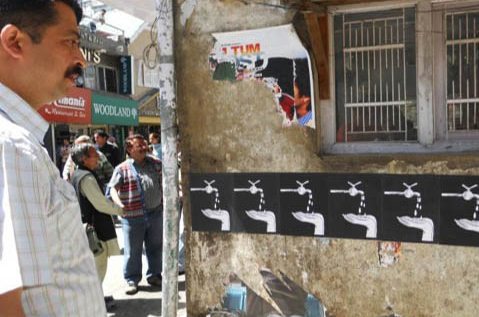
WATER CONVERSATIONS: INDIA, Paani Bachao (Save Water) with Carol Hummel USA
Shimla, Jammu, Srinagar, Delhi, Jaipur, 2010. Photo Anna Macleod.
Turkey:
- NECLA KÖSE‘s Water Paintings 16 is a performance, where she addresses the ephemerality and cyclical nature of water. In this video, she paints with water, leaving traces of herself in the different environments. But as this desire for immortality evaporates into the air, so does she. This is ironically immortalized in digital format.
USA:
- PEGI MARSHALL-AMUNDSEN ALIAS DETROIT DIVA 17 (from Detroit) is a scenographer and assistant professor that I met at a workshop in Prague. Her first cyberperformance, Good Water, was part of Waterwheel’s launch. She and her collaborator are rowers on a women’s team in Detroit. Most of their rowing occurs on the Detroit River that has a reputation by many as being ‘Bad’. But Rowers often use the expression ‘Good Water’ to describe the river when the water is still, flat, without swells or disturbance. The performance showed how rowing demands teamwork and cooperation, quick responses coupled with subtle adjustments, moves of the boat through the water – be it bad or good and over time, develops sensitivity to each other and to the water.
- ARTISTS FORMERLY KNOWN AS WOMEN 18, a collective of women from Los Angeles includes Nancy Buchanan, Deborah Krall, Sheila Pinkel, Karen Schwenkmeyer, Suzanne Siegel, and Laura Silagi. I met them online years ago, looking for artistic contribution for a cyberperformance called Sprinkler Fountain that I created with Miljana Peric (from Belgrade, Serbia) and Marischka Klinkhamer (from Amsterdam, the Netherlands) about bottled water and coal seam gas issues. The collective presented an installation performance for the Convergence/Divergence exhibition and participated also to the symposium. In white lab coats, resembling serious scientists, they decry with dark surrealistic humor the multi-billion dollar water bottle industry that exploits people’s fear.
- WENDY WOODSON 19 is a video artist, choreographer and Professor at Amherst College. I’d heard about her work through one of her talented and successful former students. I eventually met her by coincidence at the very end of a conference in Brisbane, and again in New York. She was my mentor last year during a residency in Amherst as a Copeland Fellow. We share a similar attraction to the patterns and movements of water that we translate in our video and choreographic works. Her video-poem Meeting Point with music by Meredith Monk shown in the Convergence/Divergence exhibition stands for its highly crafted editing, meshing visuals and words in rhythmical progressive emotive phrases.
- CHRISTINE DESTREMPES 20 came to a Waterwheel workshop in Massachusetts. She is a designer, illustrator, director and founder of Art for Water, an initiative to raise awareness of the shrinking availability of clean water, through the creation of monumental, public-participation art installations. She engages people of all ages as activists through creative self-expression as a path to social change, fosters stewardship of our most precious natural resource, and inspires advocacy for those living without basic needs.
- MICHELE GUIEU 21, born in southern France, spent her teenage years in Senegal, travelled and moved often, until she settled in the US in 2000 and had two children. A graphic designer and multimedia artist, she participated in the Convergence/Divergence exhibition and made a wonderful short video series, especially for the Waterwheel World Water Day Symposium 3WDS13. Each video is one personal memory about water. The footage and photos were taken at many different locations and through many years. It shows the importance of water in her life – always living close to an ocean, a sea or a river. Her father being a geologist and her mother a biologist, water was the subject of many discussions in her family, learning from a very early age to love and respect it. As a dynamic educator, she communicates this interest to young people and is part of the VOICE OF THE FUTURE committee, which launched this year a special call for youth participation in the next Symposium.
Australia:
- MARY GARDNER 22, marine biologist, writer and photographer is presently undertaking a PhD. She researches stories about the life of marine creatures, combining science and traditional indigenous knowledge. She attracts our attention to the increasing acidity of the ocean due to carbon emission, provoking dramatic consequences such as the disappearance of species and melting of small shells. Her website TANGLE OF LIFE was one of the Australian sites selected by the UN for the International Year of Biodiversity 2010
- LEAH BARCLAY 23 is a sound artist, and was curator of Floating Land in 2011 – a Festival on Lake Cootharaba, with site-specific installations. For her recent collaboration the Dam(n) Project, Leah worked with an interdisciplinary group of artists from Australia and India, to give voice to displaced communities denouncing the consequences of the construction of a dam in North India. She presented the work-in-progress at several stages for the Convergence/Divergence symposium as well as 3WDS13, for which she also made a beautiful performance using the layering of various media on the Tap with Jo Tito from New Zealand and Ilka Blue, an activist/artist from the Northern New South Wales.
- JOOLIE GIBBS 24 is an artist doing her Masters on Flood Language. She has been instrumental in the community movement saving the Mary River in Queensland from being ‘dammed’. She also organized the Farming with Mary project. International land artists where invited to respond to the place where they were in residence for two weeks, staying with farmers’ families in remote Queensland. I learned recently that Carlotta Brunetti was amongst the guest artists!
I’ve started this chapter with Carlotta in Germany, and ending it with Joolie in Australia. It is a great joy for me to see people connecting from afar, through their work and shared passion for Nature, Environment and Life! This is one of the major reasons I’ve created Waterwheel, to make and share about Water!
VIII. WATERWHEEL INITIATIVE: A YEARLY SYMPOSIUM
Waterwheel World Water Day Symposium (3WDS) is becoming a yearly initiative in order to celebrate Water and bring together the Waterwheel community.
The second edition, last March, had a terrific line up of more than 100 presenters from around the world and 7 nodes on 5 continents. (See documentation on the Waterwheel blog – type 3WDS13 in the search box.)
A dynamic new committee has worked for several months on the organization of next year’s symposium 3WDS14 and came up with a strong theme Water Views: Caring and Daring.
The symposium will happen online and in 12 nodes. Nodes are physical venues for screening portions of the programme to local audiences, as well as for hosting presenters. The symposium will be a week-long series of online events representing a diverse collection of geographically-dispersed individuals and communities. A group of WEAD artists are organising a node in the San Francisco Bay Area. Details to be announced early next year.
IX. HOW CAN WEAD MEMBERS PARTICIPATE IN 3WDS14?
WEAD members can participate in 3WDS14 Symposium by:
- uploading their proposals by 6 December.
- facilitating young people to partake, as there is a special call for Youth participation VOICE OF THE FUTURE – find link below
- joining a node or create a node – find link below
- participating online as a presenter, a performer or an audience member during the week 16-22 March 2014.
As an online audience, you will be able to comment, ask questions by typing in the text chat, and meet people from around the world in the audience. You do not need to register for that.
If you want to upload media, text, data or use the Tap for more than just viewing the symposium, you must register for free on Waterwheel 25 .
END NOTES
1 Watervoice, video-poem http://water-wheel.net/media_items/view/1075
2 Designed and made in Brisbane, Australia, Waterwheel was nominated for the prestigious international Ars Electronica 2013 Award for Digital Communities. Waterwheel was founded by Suzon Fuks, Mat Johnson, Inkahoots and Igneous.
3 ‘Lien d’Eau’ initiated by April Glover http://water-wheel.net/media_items/view/713
4 WEAD ‘Convergence/Divergence’ Exhibition http://blog.water-wheel.net/2012/11/convergence-divergence-exhibition-6-nov.html
5 WEAD ‘Convergence/Divergence’ Symposium: to watch each presentation video document, go to http://water-wheel.net/media_items/search and type ‘divergence’ in the search box
6 http://arcticperspective.org/event/api-balance-unbalance-conference
7 ‘Water Ecologies & Interdisciplinary Networks’ video document in 3 parts http://vimeo.com/waterwheel/water-ecologies-1, http://vimeo.com/waterwheel/water-ecologies-2, http://vimeo.com/waterwheel/water-ecologies-3
8 Interview with Real Time Arts magazine http://www.realtimearts.net/article/issue104/10395
9 Kate Harrinden’s presentation ‘New Flows Research. The Daily Tap’: slideshow http://water-wheel.net/media_items/view/1552, video document of the presentation http://water-wheel.net/media_items/view/1600, video document of the Q&A: http://water-wheel.net/media_items/view/1602
10 Riccardo Petrella’s interviews: http://water-wheel.net/media_items/view/613 and http://water-wheel.net/media_items/view/616
11 Carlotta Brunetti, presenting her photos – video document http://water-wheel.net/media_items/view/1530
12 Carlotta Brunetti & Rebekka Reuter: slideshows: http://water-wheel.net/media_items/view/2777 and http://water-wheel.net/media_items/view/2778
13 Hydromemories website: http://www.hydromemories.com
14 ‘Drawing the Water’ video by Pauline O’Connell http://water-wheel.net/media_items/view/1264
15 ‘Water Conversations’ by Anna MacLeod, presentation video document http://water-wheel.net/media_items/view/3314, Anna’s website http://www.annamacleod.com/
16 ‘Water Paintings’ by Necla Köse https://vimeo.com/5767303
17 ‘Good Water I’ http://water-wheel.net/media_items/view/724 and ‘Good Water II’ http://water-wheel.net/media_items/view/1454 by Pegi Marshall-Amundsen
18 Artists Formerly Known As Women presentation at ‘Convergence/Divergence’ Symposium http://water-wheel.net/media_items/view/2519, website http://whosewater.org/
19 Wendy Woodson’s website http://www3.amherst.edu/~wwoodson/
20 Christine Destrempes, Art for Water website http://artforwater.org
21 Michele Guieu’s videos https://vimeo.com/micheleguieu
22 Mary Gardner, Tangle of Life website: http://ww.tangleoflife.org
23 Leah Barclay’s website http://leahbarclay.com/
24 Joolie Gibbs project ‘Flood Language’ http://blog.water-wheel.net/2013/09/flood-language.html
25 Waterwheel registration http://water-wheel.net/users/login
WATERWHEEL & SYMPOSIUM LINKS
Waterwheel website http://water-wheel.net
Waterwheel ‘how it works’: video tutorials and manual: http://water-wheel.net/how-it-works
Waterwheel blog http://blog.water-wheel.net
Suzon Fuks website: http://suzonfuks.net
Suzon Fuks videos: https://vimeo.com/suzon
Igneous website: http://igneous.org.au
3WDS14 – main call – Waterwheel World Water Day Symposium 2014
English http://bit.ly/3WDS14-call-pdf
Spanish http://bit.ly/3wds14-convocatoria-pdf
French http://bit.ly/3WDS14-appel-pdf
portuguese http://bit.ly/3wds14-convocacao-pdf
3WDS14 – Voice of the Future – Waterwheel World Water Day Symposium 2014
English http://bit.ly/3WDS14-youth-call-pdf
Spanish http://bit.ly/3WDS14-convocatoria-joven
French http://bit.ly/3WDS14-voix-du-futur
Portuguese http://bit.ly/3WDS14-jovens-pdf

